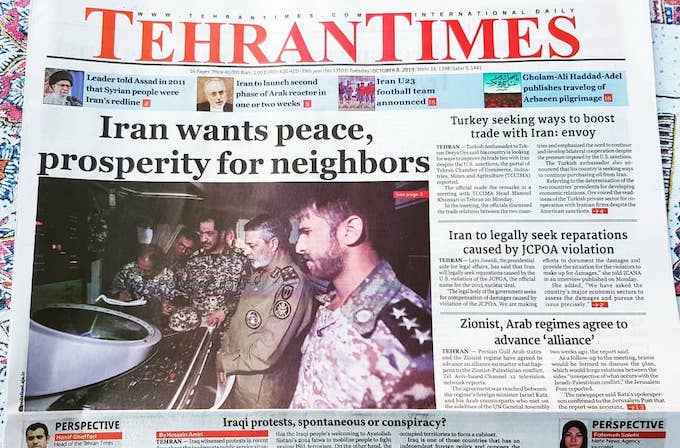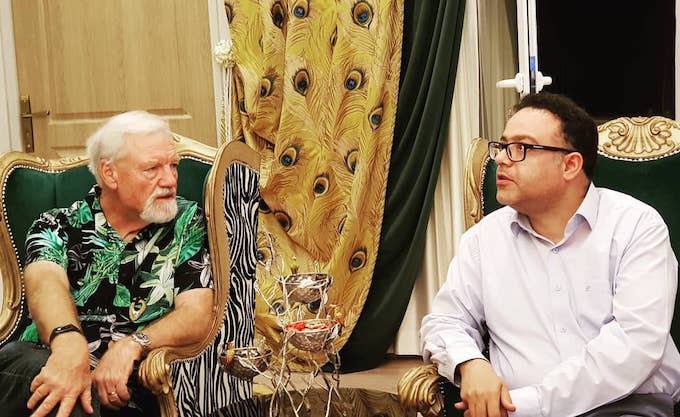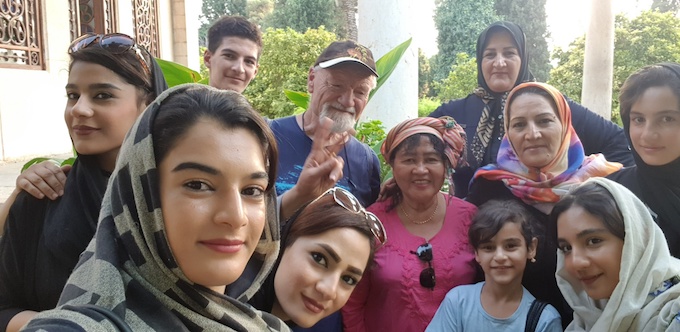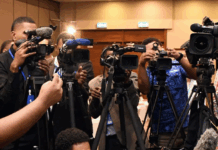
Iran attracts an onslaught of negative media in New Zealand and Western media. But is it fair or deserved? David Robie has spent several weeks travelling in the country on sabbatical and finds the media negativity far from the reality of the “most friendly” country he has ever visited in the first of a three-part series.
The headlines were chilling as we flew into Turkey and then Iran. “All out war”, trumpeted The New Zealand Herald, as being an imminent response to last month’s surprise drone attack knocking out almost 50 percent of Saudi Arabia’s oil production, blaming the attack on the Islamic Republic without convincing evidence.
President Donald Trump warned that the US was “locked and loaded” if Iran was found to be behind the attacks, and then later apparently backed off and relied on even heavier sanctions.
The next day the Herald belatedly ran the other side of the story, quoting Iranian President Hassan Rouhani’s response denying the allegations and warning that Iran would defend itself in the case of a US-Saudi attack while offering the “hand of friendship and brotherhood” for overseeing security in the Persian Gulf.
WATCH: Iran’s Rouhani – US sanctions have failed
President Hassan Rouhani says US sanctions have failed to bring Iran’s economy to its knees. Al Jazeera video
Houthi forces in neighbouring Yemen, invaded by a Saudi-led coalition in 2015 that led to widely condemned four-year civil war, claimed to have carried out the drone and rocket attack on the two oil installations at Abaiq and Khurais.
Given the rising geopolitical tensions, as I was about to visit the country for several weeks as a visitor on sabbatical, I was keen to see the realities on the ground in Iran behind the sabre-rattling.
Haven’t we seen this sort of situation before, attempts at regime change by Washington on the flimsiest of evidence? The unjustified invasion of Iraq in 2003, for example, based on the fictitious claims of Saddam Hussein’s Weapons of Mass Destruction. And look at the chaos and destruction of a nation that resulted from that overwhelming military attack.

Vietnam pretext
And then there was the 1964 manufactured Bay of Tonkin incident that was used as a pretext for US escalation of the war on North Vietnam. What a disaster with the eventual humiliating airlift withdrawal of US combat troops in 1975.
Just a few weeks before the Saudi oil installations attack, Al Jazeera UpFront interviewer and columnist Mehdi Hasan wrote in The Intercept in response to a Washington assessment blaming Iran for an earlier attack on two Saudi oil tankers in the Strait of Hormuz:
“Why would you trust the word of a single official on such a sensitive and contentious issue? And why, oh why, would you rely on the testimony of a member of the Trump administration, known globally, of course, for its stringent and unbending adherence to the truth?”
Hasan added this qualification:
“If you’re going to trust the word of a single anonymous official, in this administration of fanatical hawks and shameless dissemblers, why not trust this particular official who was quoted in The New York Times?
One American official, speaking on the condition of anonymity to discuss confidential internal planning, said the new intelligence of an increased Iranian threat was “small stuff” and did not merit the military planning being driven by Mr Bolton [then still National Security Adviser before being sacked by Trump]. The official also said the ultimate goal of the year-long economic sanctions campaign by the Trump administration was to draw Iran into an armed conflict with the United States.
Hasan added a rather stinging rebuke about the performance of Western journalists generally.
Lessons for journalists

“Plenty of journalists say they want to learn the lessons of Iraq. But the sad reality is that many of my colleagues in the media are, wittingly or unwittingly, becoming complicit in this administration’s cynical and dangerous attempt ‘to draw Iran into an armed conflict with the United States’.”
Confronted with the tensions and about to arrive in Iran for my first visit – and hopefully not last to this fascinating, friendly and vibrant country with a proud history of ancient civilisations – I consulted our MFAT’s “Travel Safe” website.
Sadly, our government’s advice to travellers is just as flawed as media reports.
Under a large red exclamation icon, the site warns “do not travel within 100km of the border with Afghanistan, within 10km of the Iraqi border or east of the line running from Bam to Jask close to the Pakistan border due to the threat of terrorism and violent crime”.
I won’t quibble about the Iraqi or Pakistan borders – as I did not personally visit those areas, but I suspect the warning is exaggerated, especially when you consider that a record 3.5 million Iranian pilgrims have just been crossing the border into Iraq peacefully, as usual, for the annual Arba’een pilgrimage to Karbala.

However, the Afghan border warning is way off the mark. I have just come back from a week-long visit to Mashhad, Iran’s second city – a beautiful and peaceful metropolis that hosts the world’s third-largest mosque, the Haram-e Razavi shrine. This is only a three-hour drive from the border.


For the next section, “Exercise increased caution”, the NZ government advisory warns: “Elsewhere in Iran exercise increased caution due to the potential for civil unrest and the regional threat of terrorism”.
Laughable advisory
Frankly, this is laughable when you consider what New Zealand suffered on March 15 with a terrorist gunman killing a total of 51 peaceful worshippers at two Christchurch mosques being a far worse attack that either of the Iranian incidents mentioned on Travel Safe – in Ahvaz on 22 September 2018 and the capital Tehran on 7 June 2017.
This does not mean no caution is needed given that the repressive rule under the Shah deposed in 1979 has been continued by the revolutionary regime. But for travellers like us, Iran is an astoundingly friendly country that welcomes tourists with genuine enthusiasm and with few overt signs of the restrictions that rile many (such as the hijab rules that have led to widespread White Wednesday protests and agitation over the tragic death of the so-called “Blue Girl” football stadium protester that gained an interim victory last week).
On September 2, 29-year-old Sahar Khodayari, set herself on fire in front of the Tehran revolutionary courthouse after learning she could face a prison sentence for up to two years following her protest attempt to enter the capital’s Azadi Stadium dressed as a boy.
She was dubbed the Blue Girl because this was the colour of her favourite team, Esteghial FC.
Although attendance by women at football matches has been banned since 1981, sometimes exceptions have been made for matches played by the national Iranian team and some women have posed as men to attend.
After Khodayari’s tragic self-immolation, a ban on women at Azadi Stadium was lifted, but it is unclear whether this is permanent or applies elsewhere in the country.
The White Wednesdays campaign was launched by US-based Iranian journalist Masih Alinejad to oppose compulsory hijab wearing.
No hijab photos
The campaign persuades women to post photos or videos of themselves without headscarves and the journalist publishes them on her social media sites. News reports have cited authorities as saying protesters face up to 10 years, but scores of women have protested anyway and been arrested.
Alinejad is followed on Instagram by almost three million people, an important influence given that other major social media platforms such as Facebook, Twitter, YouTube and Telegram are banned in Iran.
In recent weeks, the detention of two Australian social media “influencers” for allegedly taking photographs with a drone without a permit – and now set free – and the arrest of a British-Iranian social anthropologist without charge have also contributed to negative headlines. (Another dual citizen academic has been detained since 2016).
Media freedom organisations such as Paris-based Reporters Without Borders have monitored human rights violations against journalists for years. Iran is cited as the biggest jailer of women journalists.
“We reject these authoritarian rules and I would say 90 percent of Iranians don’t accept them. But we Iranians have become very good at pretending, we are very adaptable people,” says an Esfahan manufacturer, who spent time in New Zealand as a student.
Another Iranian, from Mashhad, who also studied in New Zealand, says, “Our future has been destroyed. For young people like us, we have limited choices.”
However, the country has far more nuanced realities than Western media generally give credit. Back to columnist Mehdi Hasan – what is his advice for journalists in order to provide a more balanced account of the country?
He has four suggestions: “stop the stenography”; get the facts straight; context, context, context; and get better sources.
Under his stenography heading, he condemns “passing along the claims of US officials to readers of viewers, without checking whether they are true or not”.
Getting facts right
Getting facts right – “Iran does not have nuclear weapons. Iran does not have a nuclear weapons programme. Iran has complied with the terms of the nuclear deal.”
It is the US that scuttled the nuclear deal – known as the Joint Comprehensive Plan of Action (JCPOA) – last year while Europe and the UN were satisfied it was working. Trump imposed the punitive sanctions that have rightly been branded by both Rouhani and Foreign Minister Mohammed Javad Zarif as “economic terrorism”, especially Washington’s efforts to cut off Iranian revenue from the sale of its oil (a policy currently being defiantly thwarted by China).
Clearly this blunt “maximum pressure” attempt at “regime change” has failed and now the US policy has been exposed as “maximum deceit”, according to the Iranian leadership.
Hasan says journalists ought to provide context by reporting more historical background to the issues. For example, how often do stories report that the US “Eisenhower administration toppled the democratically elected government of Iranian Prime Minister Dr Mohammad Mossadegh in a CIA coup in 1953?” He had nationalised the British-owned Anglo-Iranian oil company (later rebranded as British Petroleum).
“Or that the Carter administration offered safe haven to the repressive dictator, the Shah of Iran, after he fled from the Iranian Revolution in 1979?”


And the Reagan administration encouraged Saddam Hussein’s Iraq to launch a surprise invasion of Iran in 1981, a bitter protracted war that lasted eight years with unprepared Iranian conscripts – young and old – suffering most of the estimated one million casualties.
Hasan also urges the use of better sources. Do not simply rely on administration officials, whether in Washington or Wellington. Look to a wider range of sceptical voices and analysts. And Al Jazeera, Turkey’s TRT News and Iran’s Press TV channels are good for more balanced and background perspectives.
Among academics I have talked to, media management social scientist Professor Reza Ebrahimzadeh of the Islamic Azad University at Esfahan, argues that foreign news organisations need to do a far better job in providing “context and history” about Iran to promote global understanding.
More journalists from New Zealand need to go to Iran to see for themselves.
Dr David Robie travelled independently and with no political “minders”.












































Same as the Cuban’s you could not meet a more friendly happy bunch of people, extremely patriotic. They still hero worship Castro & Guervera after they kicked the USA ouut of Cuba.
Cuba and Vietnam are the only two countries who have managed to evict the Americans USA.
Getting facts right
Getting facts right – “Iran does not have nuclear weapons. Iran does not have a nuclear weapons programme. Iran has complied with the terms of the nuclear deal.”
Comments are closed.